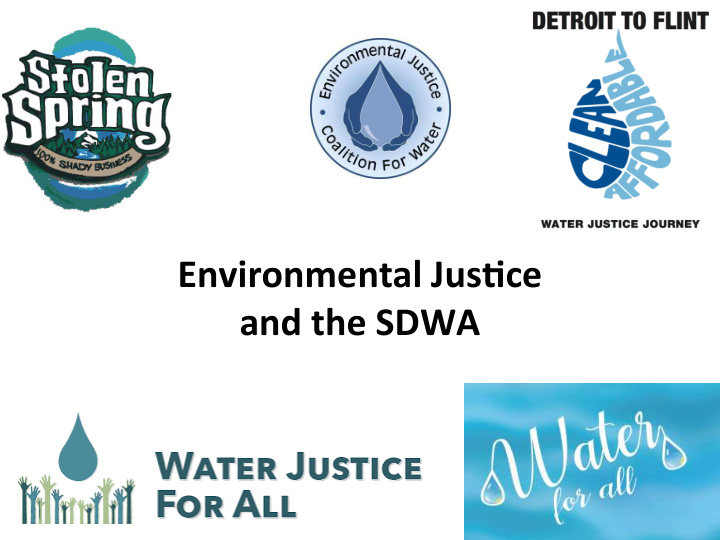



Environmental Jus0ce and the SDWA
Agenda • Who is dispropor/onately affected? • Why are they dispropor/onately affected? • What is being done? • How can we conceptualize the full set of processes influencing dispari/es?
h=ps://www.nrdc.org/resources/threats-tap- widespread-viola/ons-water-infrastructure
h=ps://www.nrdc.org/sites/default/files/threats-on-tap- water-infrastructure-protec/ons-report.pdf
Who is experiencing SDWA viola/ons? In what systems are these viola/ons occurring?
Rahman 2010 Determinants of Non-Compliance
Rahman 2010 Determinants of Non-Compliance
Health-based Viola/ons, by System Size in 2013 Rubin et al 2013 Evalua/ng Viola/ons in Drinking Water Regula/ons
Monitoring & Repor/ng Viola/ons, by System Size in 2013 Rubin et al 2013 Evalua/ng Viola/ons in Drinking Water Regula/ons
Public No/fica/on & Community Confidence Repor/ng Viola/ons, by System Size in 2013 Rubin et al 2013 Evalua/ng Viola/ons in Drinking Water Regula/ons
In 2007 0.5% to 1% of US residences did not have piped water. Many of these are • in low income communi/es which have no piped water 8% of Na/ve Americans in the USA did not have piped water. 11% did not • have safe piped water. 16% of tribally owned and operated systems had a health-based viola/on • compared with 7% na/onwide 74% of the water systems in California that violated the nitrate MCL were • located in low-income Hispanic communi/es Lead service lines are more common in older neighborhoods, which are • o_en dispropor/onately low income and minority
Switzer et al 2017 Class, Race, Ethnicity, and Jus/ce in Safe Drinking Water Compliance
Switzer et al 2017 Class, Race, Ethnicity, and Jus/ce in Safe Drinking Water Compliance
Who does not explain why!
Why might some communi/es be more likely to have viola/ons?
Why might some communi/es be more likely to have viola/ons? • Poorer ini/al water quality • Less resources • Lower capaci/es • Older infrastructure • Poor enforcement
What happens if non-compliant? • Reminder le=ers • Warning le=ers, no/ces of viola/on • Field visits • Cita/ons • Administra/ve orders • Referral to state a=orneys • Penal/es • Emergency orders to take ac/on • Criminal charges
(For 2015) h=ps://www.nrdc.org/sites/default/files/threats-on-tap- water-infrastructure-protec/ons-report.pdf
(For 2015) h=ps://www.nrdc.org/sites/default/files/threats-on-tap- water-infrastructure-protec/ons-report.pdf
Konisky 2009 Inequi/es in Enforcement
Konisky 2009 Inequi/es in Enforcement
What is being done to remedy the situa/on?
1994 Clinton’s Execu0ve Order 12898 Federal Ac0ons to Address Environmental Jus0ce in Minority Popula0ons and Low- Income popula0ons
USA Official Federal Defini0on of Environmental Jus0ce “the fair treatment and meaningful involvement of all people regardless of race, color, na/onal origin, or income with respect to the development, implementa/on, and enforcement of environmental laws, regula/ons, and policies” (EPA 2004)
Environmental Jus0ce in MassachuseOs 2002 Environmental Jus/ce Policy 2014 Execu/ve Order 552 The Massachuse=s policy defines EJ popula/ons as neighborhoods that meet one or more of the following criteria: – Median annual household income <=65% of the statewide – 25 percent of the residents are minority – 25 percent of the residents are foreign born – 25 percent of the residents are lacking English language proficiency.
h=p://maps.massgis.state.ma.us/map_ol/ej.php
USA Official Federal Defini0on of Environmental Jus0ce “the fair treatment and meaningful involvement of all people regardless of race, color, na/onal origin, or income with respect to the development, implementa/on, and enforcement of environmental laws, regula/ons, and policies” (EPA 2004)
Reasons for Lower Enforcement • Inten0onal discrimina0on: deliberate decisions made by public actors. • Logic of collec0ve ac0on . To the extent that government behavior is influenced by the poli/cal capacity of poten/ally affected popula/ons, communi/es with lower levels of poli/cal capacity (wealth, educa/on, group organiza/onal skills) are less likely to overcome free rider problems and pressure government into strictly enforcing environmental laws.
1994 Clinton’s Execu0ve Order 12898 Federal Ac0ons to Address Environmental Jus0ce in Minority Popula0ons and Low- Income popula0ons
Environmental Jus0ce in MassachuseOs 2002 Environmental Jus/ce Policy 2014 Execu/ve Order 552, updated 2017 The Massachuse=s policy defines EJ popula/ons as neighborhoods that meet one or more of the following criteria: – Median annual household income <=65% of the statewide – 25 percent of the residents are minority – 25 percent of the residents are foreign born – 25 percent of the residents are lacking English language proficiency.
State & Federal Support for EJ • SDWA requires all states to have capacity development strategies. • The Drinking Water and Clean Water State Revolving Funds allow for addi/onal subsidiza/on of disadvantaged communi/es • EPA funds the Na/onal Rural Water Associa/on and the Rural Community Assistance Partnership • EPA provides training, technical assistance
VanderSlice 2011 Drinking Water and Environmental Dispari/es
Balazs and Ray 2013 Drinking Water Dispari/es Framework
Hypotheses … from Water Economics Lecture • Capacity constraints – Lack of funding (or ability to raise capital)
Hypotheses … from Water Ins/tu/ons Lecture • Capacity constraints – Human resources – Technical exper/se • Ins/tu/onal barriers – Lack of autonomy – Culture of conserva/sm • Regulatory barriers – Too many, too difficult to understand, keep track of – Do not match the situa/on on the ground • Psychological barriers – Willingness to accept the risk of the water hazards
Hypotheses … from today’s lecture • Insufficient enforcement – Not enforced – Sanc/ons are not high enough to spark ac/on • Poli/cal barriers – Those affected by non-compliance have no voice
Recommend
More recommend